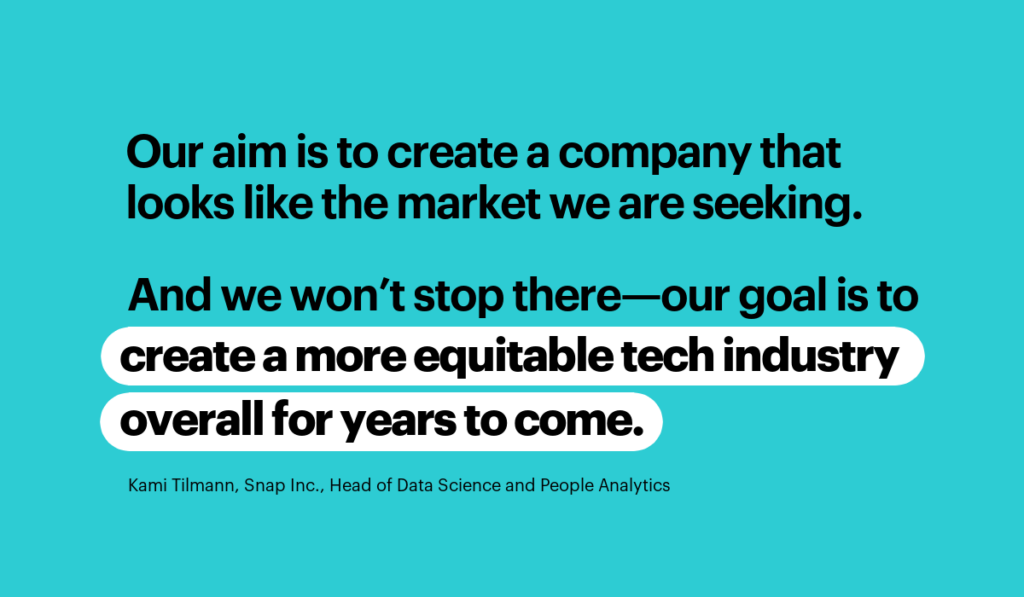How Snap Inc. Is Leading the Tech Industry in Keeping Their Diversity Pledge
Poor diversity numbers set Snap Inc. on a slow but steady DEI goals journey. Meet the data scientists helping the company to keep their diversity promise.

Data plays an important role in helping corporations make good on their diversity goals.
Corporations that vowed to “do better” when it came to implementing anti-racist and diversity programs last summer are now abandoning those pledges in droves. Promises committing to improvement are proving empty when it comes to implementing real Diversity, Equity, Inclusion, & Belonging (DEIB) programs and policies. The desire to be better may be real, but getting started is proving difficult for some—especially when receiving overwhelmingly non-diverse results of a diversity audit. Realizing actual change may feel like a Sisyphean effort, but it’s not impossible.
Just ask Snap.
Their latest public diversity report published April of 2021 shows that they still have a long way to go, but rather than accept their standing, Snap Inc. has made diversity, equity, and inclusion a top priority using a data-informed approach to bolster representation and to stay accountable. They are actively working to increase their DEI initiatives with the aim to create a company that better reflects the communities that they operate in and serve.
Start by measuring what matters
“DEI is a code that many have been trying to crack for quite some time and have, unfortunately, not moved the needle much on over the last decade,” says Kami Tilmann, Head of Data Science and People Analytics at Snap Inc.
Using data enables Kami and her Snap colleagues to keep a vigilant eye on their employee diversity, which is key to making lasting change. As the saying goes, “You measure what matters,” and when companies decide that DEI matters then ongoing measurement is a must to establish a baseline and go from there. “A big piece of our work around DEI is understanding what those levers are that can help us create more equitable processes,” Tilmann says. “Like a more inclusive work environment and a more equitable workforce.”

Snap Inc., the parent company of Snapchat, involves different groups of employees in company-wide diversity planning and efforts. These “ERG” (Employee Resource Group) ghost icons represent those groups. Top row, L-R: SnapKaleidoscope, SnapWomen, SnapFamilia, SnapNoir, SnapVets; Bottom row, L-R: SnapAbility, SnapParents, SnapPride; Bottom row, SnapAsia
While analyzing the numbers is foundational, DEI success also depends upon a “thoughtfulness approach” when it comes to taking action based on those numbers, says Shahar Gur, Senior People Insights Analyst. “It’s not just about the representation numbers going up or down. It’s about understanding where the movement and change is happening, and why,” she explains. “If something went up or down, could it be because of hiring, could it be because of attrition, could it be about trends we’re seeing in promotions. So that’s where the ‘thoughtfulness’ comes in.”
An impactful DEI plan has to start somewhere
Similar to the tech industry as a whole, Snap’s ambitious goal of changing the representation of the company from the inside—by hiring more women, more underrepresented racial and ethnic employees, and also promoting them to management roles—has proven difficult.
The tech industry is, not surprisingly, dominated by a workforce comprised heavily of white men. Upping the diversity in tech, though, is not beyond reach and Snap has already made some headway like increasing their women in tech leadership roles by double (from 6.7% to 13.7% between 2019 and 2020), while realizing smaller gains in all women employee representation (a .2% increase to 33.1%). But, it’s a start and that’s more than many companies can claim.

Other areas saw a decrease in representation, notably the number of Asian employees in leadership roles which decreased from 16.5% to 14.3%, which the company flagged as a weak point given overall Asian representation in the company was at 34.4%.
“It isn’t a secret that we have a long way to go with regard to representation,” Kami says. “So we’re kind of working towards a couple of north stars here, like making sure that we are catching up and that we are creating a company that looks like the market that we’re seeking.”
DEI success is everyone’s responsibility
Rather than resetting their goals to benchmarks they could easily tick off, Snap is keeping the bar high in a bid to “hold themselves accountable” in their bold quest for better representation.
By 2025, they plan to “increase underrepresented U.S. racial and ethnic groups to 20%, increase women in tech roles to 25% and increase women, and U.S. racial and ethnic groups by 30% in leadership” according the 2021 report.
In order to drive the change they seek, Snap has taken a holistic approach. They see DEI as everyone’s job.
“We have really lofty hiring goals. We understand that we have a long ramp ahead of us so it’s important that we weave DEI into everything we do,” explains Kami. “So it’s a combination of working with the data team, the IDEA team (Inclusion, Diversity, Equity and Awareness) and our HR team to look at HR strategy, our processes and analyzing our workforce information all through a DEI lens.”
Time will tell to see if Snap can make an impressionable dent in their numbers. It may end up being one of the greatest challenges they face.
“Our aim is to create a company that looks like the market we are seeking. And we won’t stop there—our goal is to create a more equitable tech industry overall for years to come,” Kami says.
Creating an equitable tech industry is still a long way off but with the right data, the commitment and the intention, Snap may end up cracking the diversity code while setting an admirable example of perseverance and tenacity for others in the tech industry.


